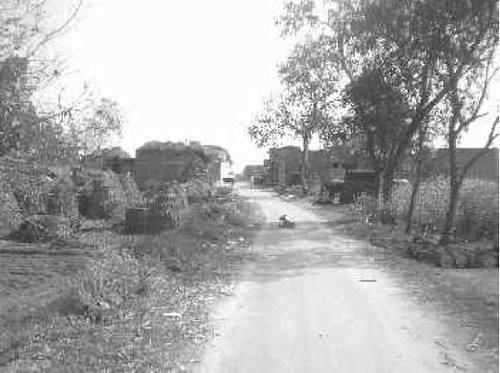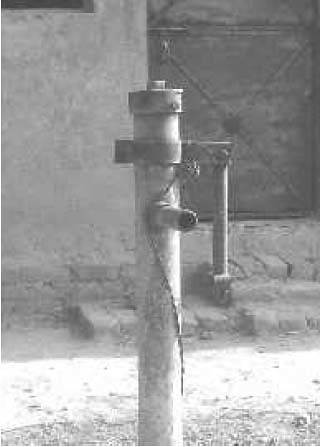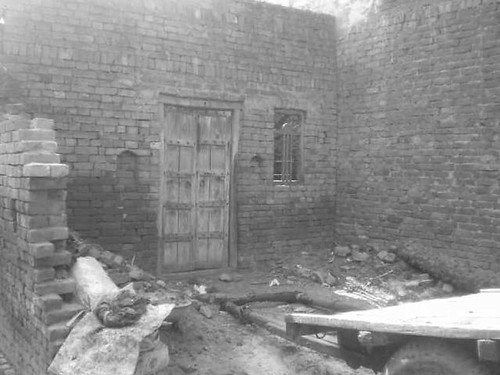Source
River Kali East The Saga of Death & Towards Revival, February, 2010
The river accommodates approximately 1200 rural and suburban areas in its due course of almost 300 Kms. Meerut alone accounts for over 40 of them.
This is the region under immediate and major impact of the pollution in the river. Because of the river flow and its speed being restricted by the added chemicals and heavy metals, the same reaches the ground water aquifers and thus leading to the same water being extracted through the hand pumps being used in the villages as the only source of drinking water and for other domestic usages.
Moreover the region is also under a superior threat of air pollution due to the chemicals present in the river and flowing along with it. A case study of a particular village is being presented herein. The village Dedwa, in Block Daurala, Meerut located on the catchment of River Kali represents a perfect example of misery being faced by Lakhs of people living on the banks of River Kali.
Village Dedwa- on the banks of the death
 The village Dedwa, in Meerut district, located on the catchment area of the river is one of the most affected villages due to deterioration of River Kali located in the Meerut district. Villages like Saini, Aurangabad and a locality named Rajvansh Vihar are facing the same problems and thus this is certainly not a singular example but is just being presented here so as to create a picture of the condition being suffered due to the unwarranted callous activities being carried on, which are responsible for chronic pollution.
The village Dedwa, in Meerut district, located on the catchment area of the river is one of the most affected villages due to deterioration of River Kali located in the Meerut district. Villages like Saini, Aurangabad and a locality named Rajvansh Vihar are facing the same problems and thus this is certainly not a singular example but is just being presented here so as to create a picture of the condition being suffered due to the unwarranted callous activities being carried on, which are responsible for chronic pollution.It is one of the first villages of Meerut facing the banks of death. It is located in Block Daurala and consists of a population of over 4000 with the following statistics giving a clear picture. It consists of a total of 1200 families approximately.
Sr. No. | Particulars | Numbers/Percentages |
1. | Male Population | 56% |
2. | Female Population | 44% |
3. | Children below 18 years of age | 1100 |
4. | Population above 60 years of age | 174 |
5. | Below poverty line | 65 families |
6. | Lower Income Group (20,000-40,000 per annum) | 54 families |
7. | Schedule casts | 1800 |
8. | Literacy | 38% |
The above mentioned records clearly are an indicator that the majority of the population is underprivileged and are highly based on agriculture or work as labourers in the local industries. The literacy rate being very low and the education still a distant dream for majority; the villagers were not able to bring their concern to the authorities. The efforts tried in the past have not been able to influence a conducive solution to this problem, themeasure of which only the villagers could know.
The few paved roads are in disrepair, while the poor quality housing reflects the lack of money available for construction and a lack of basic facilities provided by government bodies.
Impact on Health and Hygiene
The population of Dedwa has been exhibiting a frightening rise in serious ailments and also an increased death rate during the past 2 decades. The present situation is saddening and is stated in the following paragraphs.
 The water tests of the samples from the village have failed at the national and international standards for safe drinking water due to contamination with severe amount of heavy metals and thus it is unfit for human as well as usage by animals. Heavy metals bio-accumulate in human tissues, leading to increased loading and therefore increased poisoning symptoms over time, with continued exposure.
The water tests of the samples from the village have failed at the national and international standards for safe drinking water due to contamination with severe amount of heavy metals and thus it is unfit for human as well as usage by animals. Heavy metals bio-accumulate in human tissues, leading to increased loading and therefore increased poisoning symptoms over time, with continued exposure.Heavy metals are known carcinogens, increasing the prevalence of a wide range of deadly cancers. They are also known to be endocrine disruptors, interfering with hormone production and functioning. The impact of endocrine disruption is to decrease fertility and increase reproductive disorders, while impacts are particularly damaging to children, where heavy metals poisoning results in impaired growth and development of foetus and child. Maturation to adulthood may also be impaired.
A wide range of other symptoms are also seen resulting from toxic effects impairing the functioning of, and destroying, essential organs within the body, particularly the liver, kidneys and digestive system.
 It is note-worthy that approximately 80% of the population in the village is ill and is suffering from diseases which can be directly linked to the pollution being discussed herein of the River Kali. It is due to the restricted flow of the river that the river water which is extremely polluted and is consistent of various heavy metals is forced to leach into the ground water aquifers. The only source of water for domestic usage includingdrinking being the ground water is a bane for the people inhabiting the village asthe water being extracted through the hand-pumps, tube-wells and other sourcesare polluted to the levels that it can guarantee being fatal if used for a considerableamount of time. It would not be a wonder that we see an epidemic happening in thenear future. 80% demarcates a huge number and what is to be indicated herein isthat the poor villagers forced to consume slow poison needs to be pulled out of theSituation.
It is note-worthy that approximately 80% of the population in the village is ill and is suffering from diseases which can be directly linked to the pollution being discussed herein of the River Kali. It is due to the restricted flow of the river that the river water which is extremely polluted and is consistent of various heavy metals is forced to leach into the ground water aquifers. The only source of water for domestic usage includingdrinking being the ground water is a bane for the people inhabiting the village asthe water being extracted through the hand-pumps, tube-wells and other sourcesare polluted to the levels that it can guarantee being fatal if used for a considerableamount of time. It would not be a wonder that we see an epidemic happening in thenear future. 80% demarcates a huge number and what is to be indicated herein isthat the poor villagers forced to consume slow poison needs to be pulled out of theSituation.With 62 untimely deaths in the last 5 years, its a clear indication of an epidemic. It isa matter of serious concern. Shri. Rasheed Khan, a 70 year old man suffering fromstomach cancer is counting days and says, “हम तो पुराने समय में ही अच्छे थे कम से कम साफ पानी तो था पीने के लिये अब तो अल्लाह मियां से यही दुआ है कि उठा लें ये दूषित पानी तो मौत की चादर उढा ही चुका है हमें” (We were far better in the olden days, at least we had clean drinking water available, now I just pray to god to give me death formally, this dirty water has already killed me.)
It is wondering to note that the authorities are sleeping over a spreading epidemic. The following table presents an idea of the sufferings of the poor villagers.
 The government has not even taken the pain to install a medical centre in the village and the villagers had to travel to nearby towns to get their medical checkups which again lead to a financial burden over the poverty struck villagers.
The government has not even taken the pain to install a medical centre in the village and the villagers had to travel to nearby towns to get their medical checkups which again lead to a financial burden over the poverty struck villagers.With serious ailments even being a part of growth of children, the sustenance of future generations is questioned and it is almost certain that the next generation in line is going to suffer from genetic disorders and hormonal imbalances making it even more difficult to sustain.
Most of the families depend on agriculture as their source of earning and subsistence; livestock are also domesticated as a support in the farms and as a source of milk in the houses. The exposure of dirty water coming out of the underground water sources has also had an adverse effect on the health of the livestock. It has even been reported that a negative diversion in the reproductive capabilities of the livestock has been witnessed. The life cycle being distorted, as numerous sudden and unexplained deaths among the animals, is surely a step towards a raging epidemic among them as well.
The village is suffering due to what they have never contributed towards. The condition is pitiful and needs urgent attention. The water borne diseases or even the above mentioned diseases having their bases in the polluted water is a clear evident of the impact of the pollution of the river over the poor villagers.
As already mentioned this is not a maiden example and can be extended to almost 60% of the villages located on the catchment of the river.
Financial Impact
The poor villagers are getting poorer and the river water which has even affected their ground water is to be blamed. The expenditure on medical amenities is growing with each passing month and is amounting to eating up most of the income of the families in the village. Moreover as already mentioned in absence of the medical centre in the village, the ill inhabitants have to travel to nearby suburbs or Meerut City threatening the meagre income of the poor villagers.
The surveys conducted by Research & Relief Society clearly establish that a family spends approximately Rs. 3500 and more in some cases, towards the medical expenses in a month. None of the families are left spared of this calamity. It is a pity to note that to meet these medical expenses the poor families have to cut their expenditure towards other essential necessities such as clothing, proper meals, schooling etc. With poverty stuck and additional expenditure on medical bills becoming an important liability,formal education remains a far-fetched dream for the children of the village as the children if not ill are looked at as additional hands to augment income of the family. This puts the children into the vicious cycle of illiteracy and poverty and no empowerment pushing it to the next generation as well.
With an epidemic already spaced among the livestock, it has also led to affecting the financial conditions adversely. This is due to less efficiency and productivity of these animals in addition to the medical bills adding up to the expenditure of the families.
Another reason for their diminishing income is that the majority of the population is dependent on agriculture. The ground water being affected by the pollution is also a source for the water being used for irrigation. Due to the presence of heavy metals in the water in the irrigation, it has very widely affected the yield of the crops. Thecrop yield has reduced in multiple scores and thus also affecting the income of the farmers. It is a bane for the villagers as on one hand the income from the agriculture is decreasing and on other hand the expenditure on the medical amenities is increasing, thus the sustenance is getting difficult for the poverty struck villagers witheach passing day.
In addition to this, with increasing medical bills and also lessening of agricultural yield which is the major source of income in the village, the villagers get into the peril of unregulated private money lenders who charge high rate of interest and pushing the poor community into further cycle of debts and thus further poverty.
A viscous circle of economical crisis has trapped the poor inhabitants from all sides and before we witness farmers forced to commit suicide on the above mentioned grounds, the matter has to be taken up seriously and a positive action in this direction has become an utter necessity to protect the village.
Social Impact
Not only is the diminishing income of the villagers, but their very fabric of society is being threatened as an impact of this misfortune. The social interaction of the village dwellers has been restricted to within their village as their relatives and society outside, fearing to suffer from the consequences of this calamity been forced not to interact.
 The worst part of the impact at the social level is that the marriages seem to be a rare possibility in this village. No family is ready to marry a daughter in the village as she would ultimately be suffering the plight being suffered by the country folk. In addition to this, who would take a girl as a bride from a village which is affected by an epidemic of various diseases?
The worst part of the impact at the social level is that the marriages seem to be a rare possibility in this village. No family is ready to marry a daughter in the village as she would ultimately be suffering the plight being suffered by the country folk. In addition to this, who would take a girl as a bride from a village which is affected by an epidemic of various diseases?Due to all this, a large number of the villagers are getting ready to migrate but face a wide spectrum of challenges as they plan to vacate the village. Firstly, they would just have to abandon the property owned by them (as who would buy land in such a village). In addition to this, with the medical expenses already being incurred, it would be difficult to sustain at a new place.
 This gives them no option but to stay in the village in the midst of inhuman conditions without any external support. A wide array of violation of human rights is at hand in this village and to avoid any further blatant violations; some serious steps need to be taken towards emancipation of these villagers.
This gives them no option but to stay in the village in the midst of inhuman conditions without any external support. A wide array of violation of human rights is at hand in this village and to avoid any further blatant violations; some serious steps need to be taken towards emancipation of these villagers.

